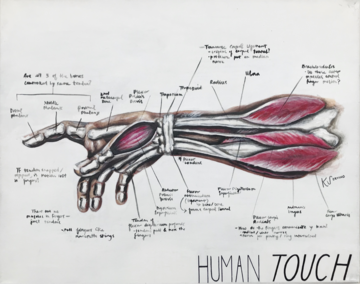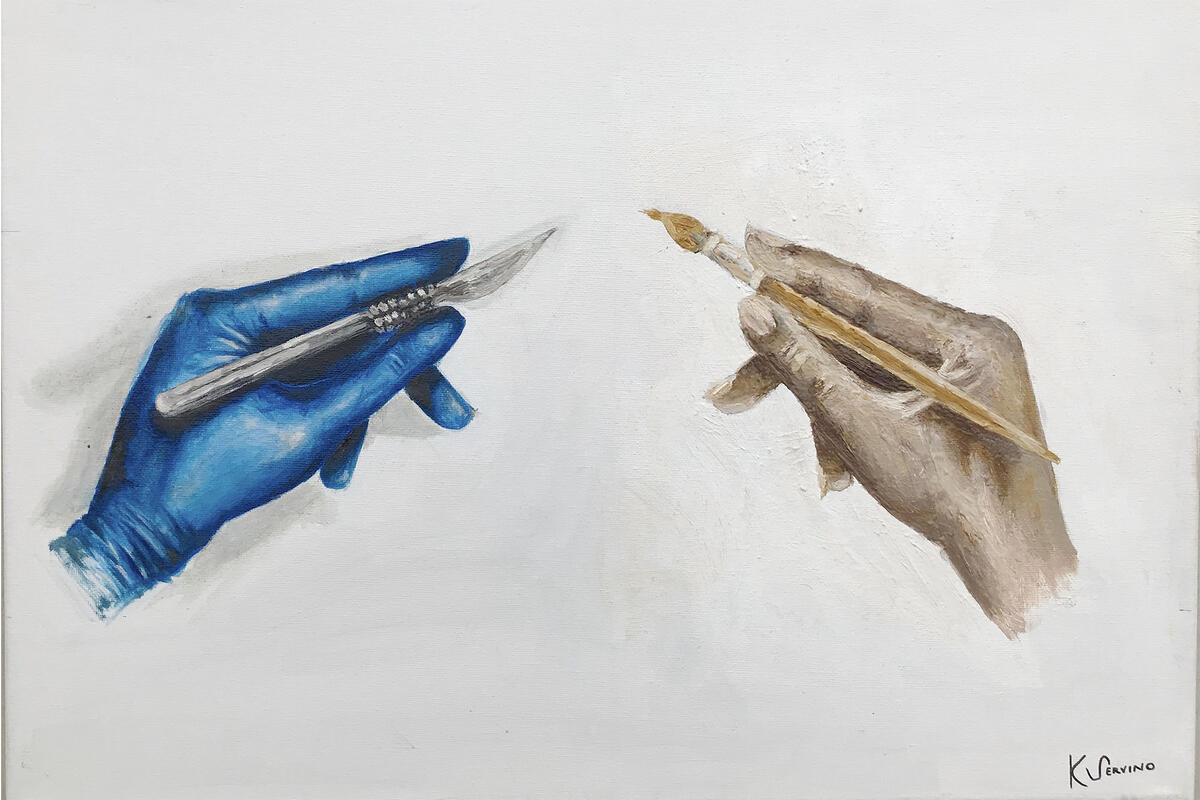COVID-19 has made everyone keenly more aware of one particular body part: our hands.
But months before the pandemic had us rethinking handshakes and disinfecting doorknobs, UNLV senior Kendahl Servino had committed herself to a year-long project focused on the human hand.

Typically, STEM students who complete undergraduate Honors College thesis will engage in lab-based research under direction from faculty within their major. Servino opted for a box-breaking approach to the project, titled Human TOUCH: Storytelling through Anatomy.
As a pre-professional biology major and award-winning artist, Servino saw the project as a way to challenge the persistent divide in higher education between STEM and humanities.
“An unintended consequence categorizing areas of study – or any number of socially constructed divisions – is the creation of boxes,” she said. “There are the boxes of gender, career, nationality, college majors, and so much more. The boxes help us understand the world, but their edges can also confine if we aren’t careful.”
Art had been a huge part of Servino’s life before college. When she declared herself a biology major in freshman year, she began missing a part of herself that no longer seemed to fit her academic and professional goals.
In 2018, she was inspired by the Life is Beautiful Student Art Competition. She submitted a series of anatomical paintings called, “The Human Circumstance,” which earned top prize.
The positive response eventually led to her transdisciplinary Honors thesis under the guidance of art professor Ashley Hairston Doughty.
The Project
Servino wanted to uncover how our associations with the human body – specifically hands – could offer insight into perceptions of ourselves and the world around us.
To accomplish this, she conducted 19 qualitative interviews based on grounded theory in which she asks participants open-ended questions such as “What do you use your hands for?” and “What words that come to mind when you think of your hands?”
She had planned to create several paintings based on the most frequent responses in the interviews. Servino was surprised, however, to find almost no overlap in the ideas expressed by interviewees.
“The lack of repetition in responses was fascinating yet was also much to my chagrin. It really showed the diversity of perspective associated with hands,” Servino said.
She ultimately chose five words that abstractly reflected the diverse responses she recorded: human, history, machine, identity, and contact.
The final product includes five original paintings representing those words and an accompanying 63-page written thesis. She details the method and results of her study while also providing a historical review of how cultures have expressed their understanding of the body – particularly the hands - both anatomically and artistically.
Her work caught some national attention. Servino was invited to present at several competitive conferences this spring but the pandemic canceled them. When all these events were canceled due to the pandemic, Servino decided to digitize the artwork into a digital gallery so that she could still share her work. [Watch Kendahl Servino thesis defense]
“My hope is that the project might prompt more discussion and investigations into the relationship between the body and self-identity,” said Servino. “And I’d love to see it inspire others to pursue more transdisciplinary projects to escape the boxes of art and science. As a future healthcare provider, I think there’s a lot of science and art in medicine.”
Servino was the recipient of privately funded scholarships through the UNLV Foundation, including the Linfa R. Wright Scholarship, MGM Academic Excellence Scholarship, and Honors Peer Mentor Scholarship. She will be attending medical school this fall.
Human TOUCH: Storytelling through Anatomy
Kendahl Servino, Ashley Hairston Doughty, MFA, Maria Jerinic, PhD, Michael Ian Borer, PhD
University of Nevada Las Vegas
Abstract: This study seeks to examine how the human body, particularly the hands, can be a focal point for sociologically understanding the way humans perceive themselves, each other, and the world around them. Using grounded theory—an inductive methodology often used in qualitative analyses—a series of conversational interviews were conducted in which participants were asked to describe their hands, what they use them for, and what associations they have with them. The aim was for the participants to share stories which would shape each unique and individual interview experience. However, in understanding more about human life and its experiences, technical analyses such as statistics and graphs are often inadequate approaches. Because of this shortcoming, I created visual representations of the data through a series of paintings. These paintings are designed to be displayed in a public forum alongside quotes from the interviews that inspired them in addition to a poster presentation of the research. As part of a trans-disciplinary investigation, one may discern the utility of presenting scientific findings through art. Through visual storytelling, this study most importantly seeks to challenge the cultural divide between art and science.

History
Oil and acrylic on canvas
“You can tell a lot about someone through their hands. You can look at the hands and learn something about a person’s life, like hard labor.
“You can analyze a person’s character by their handshake.”
”Hands have asymmetry; they aren’t the same.”
“Hands are a big giveaway as to how people are feeling, such as if their hands are shaking if they’re nervous. Arms crossed, shows that you are taking information in.”

Machine
Oil and acrylic on canvas
“When I look at someone walking, I see what the muscle and bones are doing. It’s like, and I tell my students this, that I peel back all the layers and I have x-ray vision. And in the clinical setting, it’s kind of a superpower. When someone tells you where something hurts, and you ask, how deep? You know exactly what is happening in that area.”
“When you break down the musculoskeletal system, it’s basically just a bunch of pulleys and levers. It’s really a phenomenal way of taking a mechanical system and optimizing it. There’s a large force production generated onto such a small mass and surface area - it’s brilliant.”
“When you look at a structure, you might think, these hands created this building, or that painting.”

Human
Oil and acrylic on canvas
“No other animal can use hands the way we do; opposable thumbs are unique to us. We can do many things with our hands: color, hold, comfort.”
“We use hands for simple activities of daily activity, like driving, using a pen - minute stuff to get you through your day.”
“In an open grip, you don’t see anything immediately - you only look at the body part.”
“Think of everything that you can do in this planet: drawing, playing music, or fighting - some of the worse things.”

Identity
Oil and acrylic on canvas
“There’s a reason why we say, I know something like the back of my hand.”
“It’s wonderful to me that everyone has hands but more so that everyone can choose what to do with their hands - surgery, fighting, music.”
”You’d have to change life drastically if you didn’t have your hands.”
“Not everyone has hands; those that have hands can paint, hold someone, and manipulate objects using five digits very precisely. Never take hands for granted.”

Contact
Oil and acrylic on canvas
”You can grasp at life, figuratively and physically with your hands.”
”There’s an abundance of nerve endings at hands, fingertips, which allow human beings to experience life to its fullest in such a way indescribable.”
“God gives me a helping hand with life, assisting me when I’m falling down, and I need help. His hand is there reaching out and picking me back up again. The thing that helps me get through hard times.”
“Hands provide a point of contact – for both pleasure and pain.”



